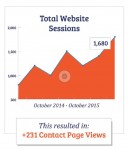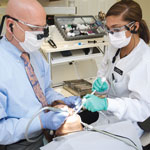In the past, traditional marketing was about pushing a message out to as many people as possible and hopefully convincing even a small number of them to take the next step—maybe calling a practice or visiting a website—and, if you were incredibly lucky, getting them to make an actual appointment.
Today, online marketing changes how dentists reach new patients. Online marketing changes the focus from pushing a message onto patients to pulling patients in for what you can offer. It’s not about convincing someone that they need your services. It’s about being in the right place at the right time when a patient is looking for a new dentist.
Pulling It Together
Effective online marketing campaigns have a lot of moving parts. These parts include streamlining your website so it will interface with Google Maps, for example. Make no mistake, it takes some time to get everything working together. The simple fact is that quality work takes time, and quality (not quantity) makes a real difference in today’s online marketing environment.
Online marketing is not a one-time activity. It’s an ongoing process. You don’t just “SEO-something” (optimize your website) once and hope for the best. When you pull the elements together in an effective marketing campaign, you reach more potential clients and become the top choice when someone searches for a dentist online.
So what does it look like when it all comes together? More specifically, what are the results when social media, an updated website, and SEO (search engine optimization) work well together? Let’s take a look at some examples.
An Effective Website
In the article, “Out of Site, Out of Mind” (Aesthetic Dentistry, Spring 2015), we wrote about what kind of image you may be projecting if your website doesn’t meet visitors’ expectations. If you have a modern, intuitive design for your website, you’re far more likely to convert visitors into future patients.
It’s easy to let a website dwindle into relative obscurity, especially if you don’t make it a priority for new patients. But on the Internet, initial perceptions are critical—if you don’t impress visitors in the first seconds they’re on your site, you’ll lose them.
If your website looks like it was made in the 1990s, it’s not going to reflect well on your business. However, if you provide the kind of online experience that your potential clients expect, they’ll spend more time on the site and it’s more likely they’ll follow through and contact your office for an appointment.
Case Study: Dr. Brian L. Britton
In 2015, we worked with a client, Dr. Brian L. Britton in Arlington, TX, to update his website, and very quickly, things changed. We tracked the number of website visitors to his website who clicked on the “Contact” page (see graph, above).
A good website landing page makes it immediately clear what the business specializes in and gives visitors a reason to find out more. In this case, we made it easy for visitors to find the information they wanted as quickly as possible. During a typical visit to the website, the average number of pages viewed per session was three—meaning that most visitors likely saw the home page (or landing page), the “About” page, and the “Contact” page. By making it easier to reach the Contact page, it also made it easier for visitors to make appointments.
Before redesigning the website, Dr. Britton’s office reported 18 new patients in January 2015 and 25 new patients in February of the same year. After many updates were implemented, the number of Internet visitors making it to the Contact page increased, as did the number of new patients. In March of 2015, Dr. Britton’s office had 36 new patients, which increased to 42 new patients in April and May of 2015.
The elements of an effective website include more than just a modern design (although that’s very important). An effective website offers a quality experience in which patients can find the information they need as quickly and easily as possible.
Making Social Media Effective
Social media is a great tool for promotion and for building authority. On many social media outlets, you can highlight testimonials, share stories about new employees in the office, and give patients a peek inside your practice with photos before they ever show up at your door.
In the Fall 2015 issue of Aesthetic Dentistry, the article, “Is Your Practice Anti-Social?” discusses the main social media platforms and the pros and cons of each platform. It’s worth reiterating that more than 93 percent of adult Internet users in the United States are on Facebook, and roughly one in every eight minutes spent online is spent on that platform. Simply stated, a vast audience is on social media, and you need to be there in order to reach them.
Today, many patients expect a certain level of connection with medical professionals. Tech-savvy patients want to see what dentists can do through photographs and videos, and they want to get to know you. Social media is where dentists are getting most of their referrals.
Building a presence on social media has many benefits. First, as you increase the number of “Likes” on your Facebook page, you build a larger audience for each of your posts. The second potential benefit is seeing people move from your Facebook or social media platform to click through to your own website where they can set up appointments.
Madison Smile Solutions, a dental practice in Madison, WI, showed significant Facebook growth as they focused on regular and relevant posts. It’s important to remember that Facebook “Likes” alone don’t really help your practice. You should look at the amount of traffic going to the website through social referrals.
Facebook is a potentially powerful tool for building an audience and generating website traffic. Madison Smile Solutions tracked 1,873 website sessions (a session is defined as a period of time a user is on the website) that resulted from people finding the site through Facebook. During the website sessions, patients had 2,389 page views (see graph, above).
Remember, different social platforms have different purposes. Don’t neglect other social media channels. While Google+ and Yelp delivered far less traffic than Facebook, users from those platforms spent more time on those websites. In addition, visitors to Google+ and Yelp looked at more pages while on those sites.
Facebook is great for “making introductions”—people see you, look at your website, and learn who you are. Google+ and Yelp, on the other hand, engage users who are looking for slightly more detailed information from dental providers.
Of course, views and virtual visits are nice, but what about new patients? How many online users actually make appointments and visit the practice?
Madison Smile Solutions saw a lot of success by using Facebook for some highly targeted ads. They used the platform to reach a wide range of potential patients, and the numbers reinforced the effectiveness of ad campaigns.
Facebook ads to targeted users was a “game-changer” for Madison Smile Solutions. The ads were surprisingly affordable (you can choose your budget and your target audience), and, in May 2015, changes were evident. Twenty-one new patients visited the practice in May, and the numbers kept growing. By December 2015, Madison Smile Solutions more than doubled the number of new patients for new appointments.
Keep in mind, when you initiate a social media campaign, “Likes” are important, but not as important as getting new patients through the door.
Finding You Online
Today, the most common way for users to find a dentist is through a simple Google search. They may be looking for all the dentists in the area, or they may have heard of your practice specifically and want to know more about you.
Search engine optimization, which ensures a site’s visibility in a search engine, streamlines the nuts and bolts of your website, and positions important pages to attract visitors who are ready to become your patients. Optimizing your site according to the search engine guidelines can help your listing show up at the top of a new dentist search. Building your rankings and traffic can take some time, but when it’s done well, you will see a steady growth of visitors to your site.
In one dental practice, the number of people who found the office through a variety of keyword searches led to 1,680 sessions from 1,108 new users. On average, Internet viewers visited three pages per session, and 231 of those users ended up on the “Contact” form.
As long as search engines rely on complex algorithms to deliver results to users (based on the keywords they use in their search), dentists will need to continually update and optimize their sites to meet those rules, guidelines, and expectations.
“Pull marketing” is all about getting customers to come to you, and in this article we’ve talked a lot about how a good website, social media, and search engine optimization all contribute to getting better results. But exactly what kind of results can you expect? Will this really lead to more patients setting more appointments? The numbers show that it does.
Dr. Britton has seen 121 percent growth in new patients by implementing these facets of a marketing campaign, while Madison Smile Solutions has seen 58 percent growth. There are a lot of people in your local area looking for a dentist right now, and if you know how to reach them in the right place and at the right time, you will be uniquely positioned to start seeing this kind of growth.
Sources:
http://www.pewinternet.org/2015/08/19/the-demographics-of-social-media-users/
http://newsroom.fb.com/company-info/
http://www.sesamecommunications.com/wp-content/uploads/2013/04/Social-Media-Marketing.pdf













